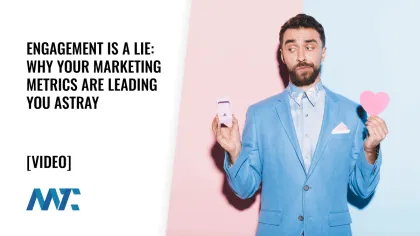
If a guy talks to his girlfriend 83% more this month than last month, is he engaged? What if he left a few comments on her social media posts? Does that make him engaged?
No.
The definitions of engagement are clear:
(1) A formal agreement to get married.
Merriam Webster Definition of Engagement
(2) An arrangement to do something or go somewhere at a fixed time.
Yet, in the marketing world, engagement has been twisted into a vanity metric that often lacks real business impact. Years ago, I published a rant calling out marketers for abusing metrics without tying them to actual results. Fast-forward to today, and it’s still happening—so here I am again, talking about it.
The Problem with “Engagement” as a Metric
Time spent on a page, number of comments, followers, votes, or even minutes of video watched mean nothing unless they drive actual business results. If you can’t connect engagement to revenue, conversions, or other measurable goals, then it’s just a feel-good number.
I still see too many businesses throwing money at content that doesn’t lead to sales, leads, or meaningful interactions. They’re mistaking attention for action. They’re confusing dating with engagement.
Engagement vs. Dating in Marketing
Dating is when two people interact, assess compatibility, and figure out if they want to take the relationship further. Sound familiar?
If your visitors are spending more time on your site, congratulations! You’re dating. That’s a good sign—it means they’re interested. But unless they take action, such as making a purchase, signing up for a service, or subscribing to something valuable, they’re not engaged.
When they buy the ring and commit—meaning they convert and become paying customers—then we can talk about engagement.
The Social Media Engagement Illusion
Marketers who struggle to prove ROI often hide behind the term engagement. They flaunt stats like increased views, shares, or likes as proof of success. But is it?
Take the infamous Travelocity campaign featuring their gnome on MySpace. By traditional engagement metrics, it was a massive success. People befriended the gnome, commented, interacted, and the campaign generated tons of exposure. But here’s the kicker: it cost $300K and didn’t drive business. No measurable return. No engagement—just expensive dating.
The Right Way to Measure Engagement
True engagement isn’t about numbers; it’s about meaningful actions. That means:
- Conversions: Are people signing up, buying, or moving down your sales funnel?
- Retention: Are they coming back, staying loyal, and advocating for your brand?
- Revenue Impact: Can you track a direct financial benefit from their actions?
It’s not that social media engagement is useless—it’s that it must be aligned with business objectives. If you define success upfront and track how engagement leads to sales, then and only then does it become a valuable metric.
Takeaway
Marketers need to stop using engagement as a blanket justification for wasted efforts. If your content generates millions of views but no business, it’s a vanity project. If you align your content strategy with business goals and track results effectively, that’s true engagement.
So before celebrating that spike in comments, ask yourself: Are they dating you, or are they committing to the relationship?